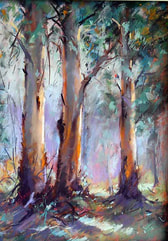
MAUREEN Loughran’s passion is to travel to picturesque locations abroad and capture the images she sees on her canvases. She loves her Bass Coast with an equal passion but in Europe there lie the ancient villages, cobblestoned pathways and gnarled olive trees still producing fruit after hundreds of years that cannot be found in Australia. Of course she asks her husband Peter to join her, but he is just as happy for her to enjoy her artistic pursuits in the company of other like-minded artists, and also happy he doesn’t have to step on board a plane.
Maureen was born and bred in Wonthaggi of Italian parents who came as children to Wonthaggi, like so many escaping the harsh life of peasants in the north of Italy in the post-war years. Maureen was the eldest of five children, with the rest of them boys so you can imagine that there was neither the money nor the inclination for her parents to fund her to study at art school. Her role was to join the workforce as early as possible.
Maureen found she had the love of art and the aptitude when she was still at school at St Joseph’s. The nuns were tough. You were seen but not heard. But there was one nun, Sister Bernard, who encouraged her and would wait with her in the classroom when everyone else had left, just to see Maureen’s finished work. Maureen laughingly tells me that it will indicate her age, but she started drawing on slate, but then later on paper and finally on canvas.
It was many years later, after marriage and two lovely girls, that Maureen found her way back to her art. Her mother had just passed away and it was a way of dealing with that grief. It was in 1978 that she joined her first art group and joined Colin Johnson in his summer workshops. She was hooked.
In 1982 she joined Lance Sullivan’s classes in Korumburra where he insisted that paintings must never be arrived at by the study of a photograph, but done en plein air. She was quite daunted at first, but then embraced it. She tells me the fastest work she has done was completed in the 20 minutes that it took for a magnificent sunset to rage across the sky as she sat in darkness and painted like a mad woman with a palette knife.
While she enjoys painting in oils, she is always drawn back to watercolour. Emerald artist Ron Carter Green helped her with her chosen medium. Maureen’s eyes sparkle as she explains to me the feeling of letting the water do the work, finding its way across paper that bounces under her brush. But then she tells me that you never know what you have until it dries. There have been times when she has been thrilled with the result of wet paper, only to be disappointed as it dries and loses its luminosity as she had not given the water enough colour.
She clearly loves the company of other artists. In 1987 she was invited to join a group called the Gippsland 8, a group of artists from all parts of Gippsland who exhibited twice a year throughout Victoria until 1996. She is also part of an all-women group of artists that call themselves Town and Country and for the last 22 years have found a country escape for two weeks where they can paint and enjoy one another’s company.
The first time she exhibited was at the Leongatha Art Show. She entered with a piece she was quite proud of, a seascape with Eagles Nest on the Bunurong Coast. When she turned up to the show, she searched and searched before she found it tucked away in a corner. All she wanted to do was to grab it and run away with it. In her mind she said, “Who am I kidding? I can’t paint like these other artists.”
But she persisted with her art. So much so that she has now won many prizes, with four of her pieces now part of the Bass Coast Council’s Art Collection. I ask for her secret. She tells me, “Failure teaches you more.”
Maureen has been a long-time member of the Australian Guild of Realist Artists, and the Victorian Artists Society. In 2015, after a solo exhibition in Melbourne, she was invited to join the Melbourne Society of Women Painters and Sculptors.
She has now travelled back to the native country of her parents and has revelled in listening to the children play, squealing in Italian, watching the old men drink their little bit of grappa in their coffee in the morning, and fine-tuned her gnocchi making skills. She has painted the centuries-old seaside villages of Cinque Terra on the rugged Italian Riviera coastline, where the fishing boats fill the harbours and the colourful houses and vineyards cling to steep terraces, the conical thatched roofed limestone Trulli houses of Alberobello, and the rugged island of Lipari of the Aeolian Islands. She has travelled to Greece to paint on two occasions and in September will return to Italy.
But always she is drawn back to the sea of Cape Paterson where life is not complete without a walk along the beach each morning.
I ask her how many painting of the sea she has painted so far. “Oh, about a thousand.” She explains, “The sea is never the same. It is always changing, with the seasons and with the time of the day.
“And then, I learn from everyone, I feed off them and grab anything that comes my way. I always believe that other artists are better than me. That is my inspiration.”